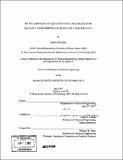Development of quantitative methods for quality assessment of islets of Langerhans
Author(s)
Pisania, Anna
DownloadFull printable version (22.89Mb)
Other Contributors
Massachusetts Institute of Technology. Dept. of Chemical Engineering.
Advisor
Clark K. Colton.
Terms of use
Metadata
Show full item recordAbstract
Transplantation of isolated islets of Langerhans has promising potential to cure type 1 diabetes by inducing long-term normoglycemia and insulin independence. The feasibility of clinical islet transplantations has been established according to the Edmonton Protocol. However, results are variable, and it is not yet possible to predict transplantation outcome from in vitro measurements with islet preparations. Currently, islet enumeration is based on microscopic visualization after staining with a zinc-specific binding dye (dithizone, DTZ) and manual counting with normalization on the basis of an islet equivalent (IE), an islet with volume equivalent to that of a sphere with a 150 Pm diameter. Islet viability is based on a live/dead staining test with two fluorescent dyes, fluorescein diacetate (FDA) and propidium iodide (PI). These methods are operator- dependent and prone to error due to the variability in islet size and shape and are not predictive of transplantation outcome. We developed quantitative assays that allowed reproducible evaluation of meaningful properties that affect the clinical outcome in impure human islet preparations. For purity estimation, we examined light microscopic (LM) morphological analysis of 1-jm sections to estimate the islet volume fraction and compared the results with those of electron microscopy (EM) ultrastructural analysis on the same preparations. (cont.) For quantifying the total number of cells in a preparation, we developed an assay based on nuclei counting and compared three different counting methods: (1) visual counting in a hemacytometer and automatic counting by (2) aperture resistance measurements (Coulter Multisizer II) and (3) flow cytometer measurements (Guava PCA). The methods differed in the way nuclei were distinguished from fragments, accuracy, time required and range of linearity. Total amount of tissue was also quantified by DNA measurements. A theoretical framework was developed in order to combine volume fraction data from the LM analysis with the total number of cells in the tissue from nuclei measurements in order to estimate the total number of islets present in impure preparations. To evaluate tissue viability, we used oxygen consumption rate measurements (OCR), an assay of mitochondrial function. We developed a very small stirred chamber system (Micro Oxygen Uptake System, Model FO/SYS210T, Instech Laboratories, Plymouth Meeting, PA) specifically designed for measurements with islets. OCR measurements combined with an assay of total amount of tissue quantification (nuclei counting or DNA analysis) provide a measure of the tissue fractional viability. (cont.) We used the methods we developed to characterize a large number of islet preparations of different species prior to and following culture. We also studied the transient response of cells and islets to various stresses, as reflected by assays of different type. We found that membrane integrity tests are poor indicators of the fractional viability of a cell sample, while mitochondrial function assays identify cell death at its earlier stages. We examined the predictive capability of the assays we developed through in vivo studies. Ttransplantation experiments were performed with rat islets implanted into mice and high purity fraction of human islets transplanted into mice. We found that OCR measurements combined with a measure of total amount of tissue (nuclei or DNA) are good predictors of the transplantation outcome.
Description
Thesis (Ph. D.)--Massachusetts Institute of Technology, Dept. of Chemical Engineering, 2007. Includes bibliographical references (p. 241-257).
Date issued
2007Department
Massachusetts Institute of Technology. Department of Chemical EngineeringPublisher
Massachusetts Institute of Technology
Keywords
Chemical Engineering.